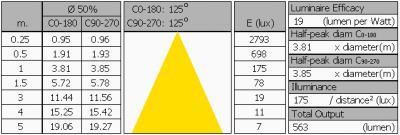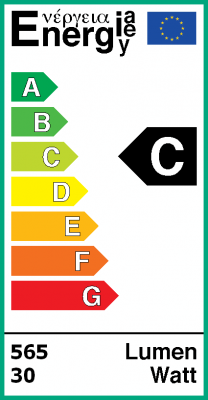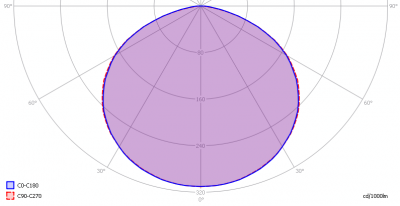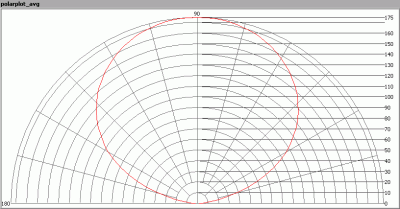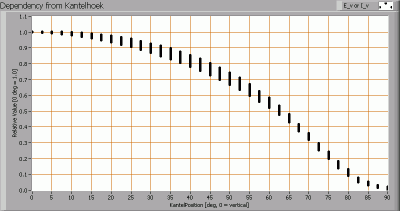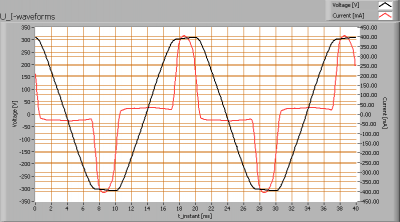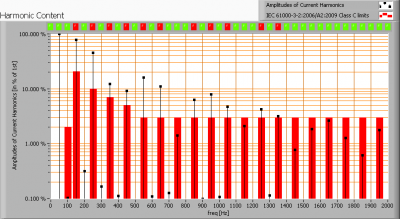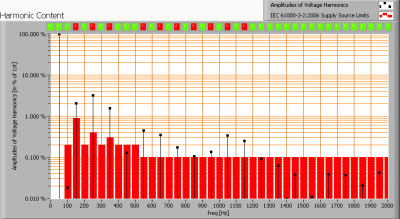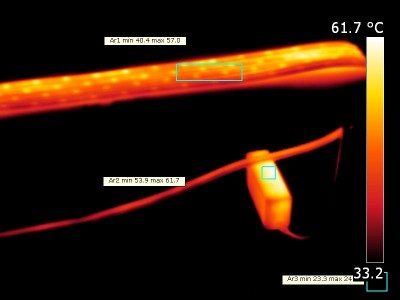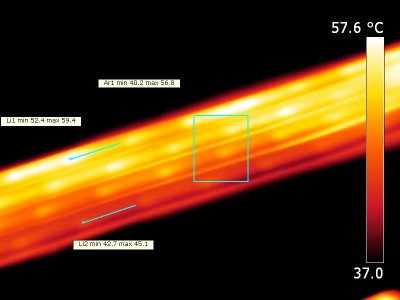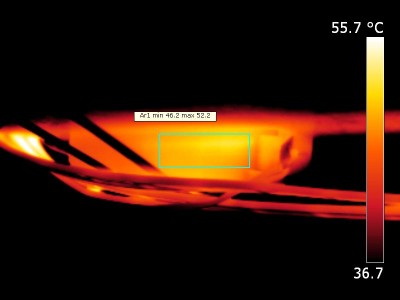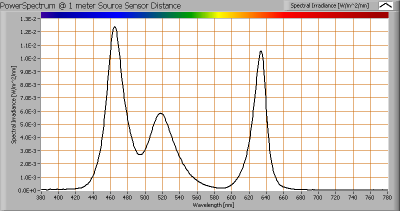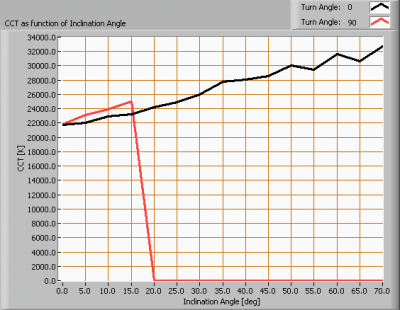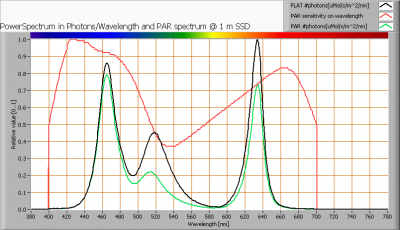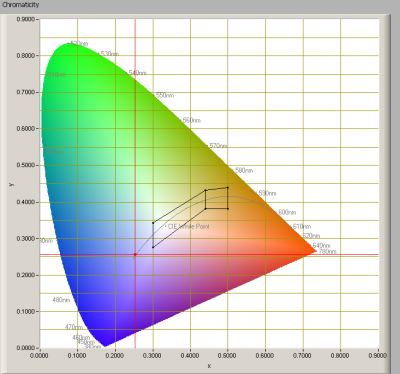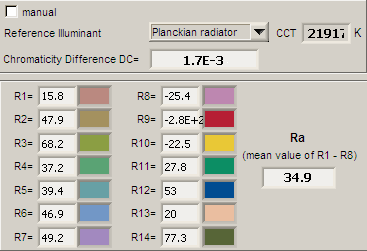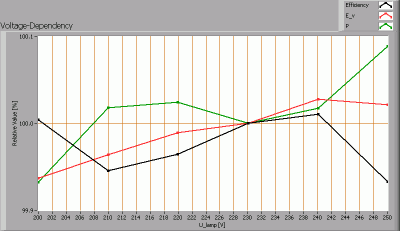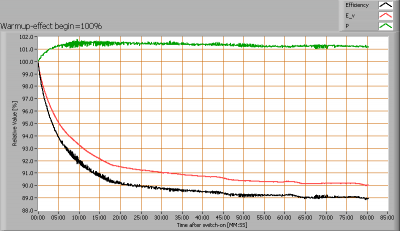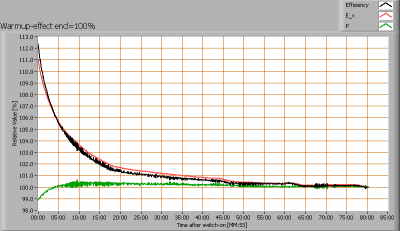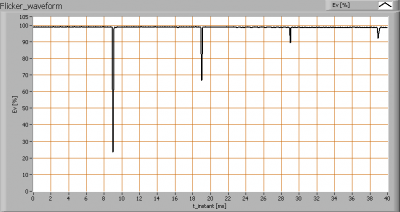KLV Ledverlichting – KLV_MASTRIP_RGB_test
Posted by Marcel van der Steen in Led lights, Light measurements No Comments» presents a ledstring consisting of 140 RGB leds. With help of a controller one can select many light effects (only red, green or blue, or changing from one color to the other, or flickering etc). The selection “static white” (assumed that all three leds are maximally on) is chosen to do the measurement, this to get the maximum luminous flux.
presents a ledstring consisting of 140 RGB leds. With help of a controller one can select many light effects (only red, green or blue, or changing from one color to the other, or flickering etc). The selection “static white” (assumed that all three leds are maximally on) is chosen to do the measurement, this to get the maximum luminous flux.
This article shows the measurement results. Many parameters are also found in the Eulumdat file.
See this overview for a comparison with other light bulbs.

Summary measurement data
| parameter | meas. result | remark |
|---|---|---|
| Color temperature | 21917 K | Very cold white. This is an effect of putting all three leds to 100 %. Other color temperatures would result if the led would be lit at different percentages. |
| Luminous intensity Iv | 175 Cd | Measured straight underneath the lamp. |
| Illuminance modulation index | 62 % | Measured straight underneath the lamp. Is a measure for the amount of flickering.
Note: there are a few small peaks (high frequency) that differe in modulation dept. So this flickering will not be visible. |
| Beam angle | 125 deg | 125º for the C0-C180-plane (perpendicular to the length direction of the strip) and 125º for the C90-C270 plane, which is along the length direction of the lamp. |
| Power P | 30.1 W | |
| Power Factor | 0.69 | For every 1 kWh net power consumed, there has been 1.0 kVAhr for reactive power. |
| THD | 94 % | Total Harmonic Distortion |
| Luminous flux | 563 Lm | |
| Luminous efficacy | 19 Lm/W | |
| EU-label classification | C | The energy class, from A (more efficient) to G (least efficient). |
| CRI_Ra | 35 | Color Rendering Index. This low value is due to the chosen setup of all on. Driving the R, G and B leds at different intensities results in different results for the CRI. |
| Coordinates chromaticity diagram | x=0.2531 and y=0.2569 | |
| Fitting | 230V | This lamp is connected, via the adaptor, directly to the 230 V grid voltage. |
| PAR-value | 2.6 μMol/s/m2 | The number of photons seen by an average plant when it is lit by the light of this light bulb. Value valid at 1 m distance from light bulb. |
| PAR-photon efficacy | 0.3 μMol/s/We | The toal emitted number of photons by this light, divided by its consumption in W. It indicates a kind of efficacy in generating photons. |
| S/P ratio | 4.1 | This factor indicates the amount of times more efficient the light of this light bulb is perceived under scotopic circumstances (low environmental light level). |
| L x W x H external dimensions | 5000 x 12 x 4 mm | External dimensions of the lamp. |
| L x W luminous area | 5000 x 8 mm | Dimensions of the luminous area (used in Eulumdat file). This is the surface of the flexible printed circuit board in which the leds are mounted. |
| General remarks | The ambient temperature during the whole set of measurements was 24.0 – 25.3 deg C.
The temperature of the housing gets about 34 degrees hotter than ambient temperature. Warm up effect: during the warm up time the illuminance and consumed power vary less than 10 %. Voltage dependency: the power consumption and illuminance vary insignificantly, when the power voltage varies between 200-250 V. At the end of this article there is an additional photo. |
|
| Measurement report (PDF) | ||
| Eulumdat file |  |
Right click on icon and save the file. |
Overview table
The overview table is explained on the OliNo website.
Note: the minimum distance for which the E [lux] values are valid, is dependent on the layout of the strip. Laid out straightly over its 5000 mm then the minimum distance should be 5 x 5000 mm to be able to consider this light source as a point source and to be able to compute the Ev values at even bigger distances according to an inverse square law. However this is not pratical.
One other way to look at it is to observe 1 m of string length, which emits 110 lumen (1/5th of the total).
Now if it is needed to get a rought idea of the illuminance on a small distance, say 50 cm, then consider 1/5th of this distance of the lamp, here 10 cm. This part of the string will emit 1/50 * 563 lx = 11 lx (at 50 cm). Now the string is longer than that so the remainder will add luminance to it, but always less as it is further away. With help of a program like Dialux this can all be calculated, use the eulumdat file for that as given in the table above.
EU Energy label classfication
With the measurement results of the luminous flux and the consumed power the classification on energy of this lamp is calculated. This information is requested in the EU for certain household lamps, see also the OliNo site that explains for which lamps it is requested, how the label looks like and what information it needs to contain.
Herewith the labels for this lamp in color and black and white.
EU energy label of this lamp
Label in black and white.
Eulumdat light diagram
This light diagram below comes from the program Qlumedit, that extracts these diagrams from an Eulumdat file. It is explained on the OliNo site.
The light diagram giving the radiation pattern.
It indicates the luminous intensity around the light bulb. The C0-C180 plane is along the width direction of the lamp) and is the same as that of the C90-C270 plane (along the length direction of the lamp).
Illuminance Ev at 1 m distance, or luminous intensity Iv
Herewith the plot of the averaged luminous intensity Iv as a function of the inclination angle with the light bulb.
The radiation pattern of the light bulb.
This radiation pattern is the average of the light output of the light diagram given earlier. Also, in this graph the luminous intensity is given in Cd.
These averaged values are used (later) to compute the lumen output.
Intensity data of every measured turn angle at each inclination angle.
This plot shows per inclination angle the intensity measurement results for each turn angle at that inclination angle. There normally are differences in illuminance values for different turn angles. However for further calculations the averaged values will be used.
When using the average values per inclination angle, the beam angle can be computed, being 125º for the C0-C180 and 125º for the C90-C270 plane.
Luminous flux
With the averaged illuminance data at 1 m distance, taken from the graph showing the averaged radiation pattern, it is possible to compute the luminous flux.
The result of this computation for this light spot is a luminous flux of 563 Lm.
Luminous efficacy
The luminous flux being 563 Lm, and the power of the light bulb being 30.1 W, yields a luminous efficacy of 19 Lm/W.
Electrical properties
A power factor of 0.69 means that for every 1 kWh net power consumed, a reactive component of 1.0 kVAr was needed.
| Lamp voltage | 230 VAC |
| Lamp current | 189 mA |
| Power P | 30.1 W |
| Apparent power S | 43.6 VA |
| Power factor | 0.69 |
Of this light bulb the voltage across ad the resulting current through it are measured and graphed. See the OliNo site how this is obtained.
Voltage across and current through the lightbulb
This waveforms have been checked on requirements posed by the norm IEC 61000-3-2:2006 (including up to A2:2009). See also the explanation on the OliNo website.
Harmonics in in the current waveform and checked against IEC61000-3-2:2006 and A2:2009
There are limits for the harmonics for lighting equipment > 25 W which according to this measurement are not met.
Note that the voltage used to drive this lamp does not comply with the requirements, and it has more harmonic content. This adds to the harmonic content of the current. So the result of this measurement cannot be taken as decisive, but it is an indication. To be complete herewith the harmonic content of the used voltage.
Harmonics in in the voltage waveform and checked against IEC61000-3-2:2006 and A2:2009
The Total Harmonic Distortion of the current is computed as 94 %.
Temperature measurements lamp
Overview: the adapter and the ledstring
Zoomed in on the ledstring
One side of the string gets noticeably hotter than the other side. The reason is that the part of the string close to the adapter carries the current for all leds, whereas at the end of the string the current for the few leds in that part is carried only; leading to less heat dissipation in the tracks of the flexible printed circuit board.
The controller
All components have a rought surfface so their emissivity is taken high, 0.95.
| status lamp | > 2 hours on |
| ambient temperature | 23.5 deg C |
| reflected background temperature | 23.5 deg C |
| camera | Flir T335 |
| emissivity | 0.95(1) |
| measurement distance | 0.4 and 0.6 m |
| IFOVgeometric | 0.136 mm per 0.1 m distance |
| NETD (thermal sensitivity) | 50 mK |
(1) See the text for explanation.
Color temperature and Spectral power distribution
The spectral power distribution of this light bulb, energies on y-axis valid at 1 m distance.
The measured color temperature is about 21900 K which is very cold white.
This color temperature is measured straight underneath the light bulb. Below a graph showing the color temperature for different inclination angles.
Color temperature as a function of inclination angle.
The measurement of CCT is measured for inclination angles up to 70º. Beyond this angle the illuminance is very low (< 5 lux).
The beam angle is 125º, meaning a 62.5º inclination angle. In this area most of the light is present. The variation in correlated color temperature in this area cannot be given. As can be seen on the red line, the color temperature is not existent for all positions in which it has been measured. This is due to the choice of putting all R, G and B leds at maximum output, not considering a setting where a better CCT or even CRI would result from. The target was to measure the maximum mount of luminous flux which could be done by putting all lR, G and B leds to their maximum output.
PAR value and PAR spectrum
To make a statement how well the light of this light bulb is for growing plants, the PAR-area needs to be determined. See the OliNo website how this all is determined and the explanation of the graph.
The photon spectrum, then the sensitivity curve and as result the final PAR spectrum of the light of this light bulb
| parameter | value | unit |
|---|---|---|
| PAR-number | 2.6 | μMol/s/m² |
| PAR-photon current | 8.3 | μMol/s |
| PAR-photon efficacy | 0.3 | μMol/s/W |
The PAR efficiency is 72 % (valid for the PAR wave length range of 400 – 700 nm). So maximally 72 % of the total of photons in the light is effectively used by the average plant (since the plant might not take 100 % of the photons at the frequency where its relative sensitivity is 100 %).
S/P ratio
The S/P ratio and measurement is explained on the OliNo website. Here the results are given.
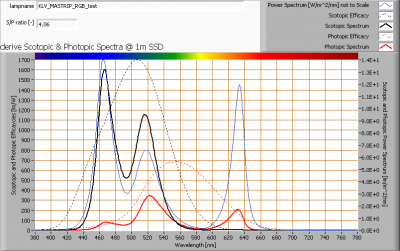
The power spectrum, sensitivity curves and resulting scotopic and photopic spectra (spectra energy content defined at 1 m distance).
The S/P ratio is 4.1.
This very high value is also coming from a lot of blue content as also the blue led is maximally on. A lot of blue does not add much to the (photopic) lumen output but it does make the S/P ratio high.
More info on S/P ratio can be found on the OliNo website.
Chromaticity diagram
The chromaticity space and the position of the lamp’s color coordinates in it.
The light coming from this lamp is outside the area of class A. This is an area defined for signal lamps, see also the OliNo website.
Its coordinates are x=0.2531 and y=0.2569.
Color Rendering Index (CRI) or also Ra
Herewith the image showing the CRI as well as how well different colors are represented (rendered). The higher the number, the better the resemblance with the color when a black body radiator would have been used (the sun, or an incandescent lamp). Practical information and also some critics about the CRI can be found on the OliNo website.
Each color has an index Rx, and the first 8 indexes (R1 .. R8) are averaged to compute the Ra which is equivalent to the CRI.
CRI of the light of this lightbulb.
The value of 35 is (much) lower than to the value 80 which is considered a minimum value for indoor usage. The usage of the lamp is not for reading, but for specific illumination or for a specific atmosphere. So the CRI value is not important in that sort of applications. By varying the amount of blue, red and green other values for CRI will result.
Note: the chromaticity difference is 0.0017 indicates the distance to the Planckian Locus. There is no norm yet that states what the max deviation from white light is allowed to be. A reference with signal lights as a reference is given in the chromaticity diagram.
Voltage dependency
The dependency of a number of lamp parameters on the lamp voltage is determined. For this, the lamp voltage has been varied and its effect on the following light bulb parameters measured: illuminance E_v [lx], the lamppower P [W] and the luminous efficacy [Lm/W].
Lamp voltage dependencies of certain light bulb parameters, where the value at 230 V is taken as 100 %.
The illuminance and consumed power vary insignificantly when the voltage is varied.
When the voltage at 230 V varies with + and – 5 V, then the illuminance varies < 0.1 %, so when abrupt voltage changes occur this effect is not visible in the illuminance output.
Warm up effects
After switch on of a cold lamp, the effect of heating up of the lamp is measured on illuminance E_v [lx], the lamppower P [W] and the luminous efficacy [lm/W].
Effect of warming up on different light bulb parameters. At top the 100 % level is put at begin, and at bottom at the end.
The warm up time is about 30 minutes during which the illuminance decreases with 10 %.
Measure of flickering
An analysis is done on the measure of flickering of the light output by this light bulb. See the OliNo site for more information.
The measure of fast illuminance variation of the light of the light bulb
| parameter | value | unit |
|---|---|---|
| Flicker frequency | 3707 | Hz |
| Illuminance modulation index | 62 | % |
The illuminance modulation index is computed as: (max_Ev – min_Ev) / (max_Ev + min_Ev).
As can be seen the modulation is very different from moment to moment. Only small dips in illuminance are seen every 100th of a second. As the drop for a very small period of time, this will not be noticeable.
Extra foto

Detail photo of the RGB led on the flexible printed circuit board
